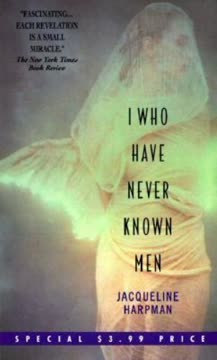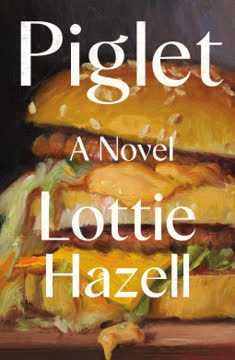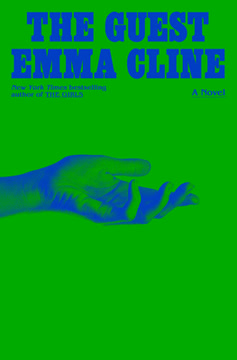Key Takeaways
1. Greta: The Secret Listener
Now secrets were fed directly into her ears, without any of the piped-in music or body pain.
A new life. Greta moves to Hudson, New York, seeking isolation and a fresh start after quitting her pharmacy job, ending a long engagement, and leaving California. She finds work transcribing therapy sessions for a local sex and relationship coach named Om, whose real name is Bruce. This job allows her to work from home, avoiding social interaction and physical discomfort.
Eavesdropping on lives. Her job involves typing verbatim transcripts of Om's sessions, giving her intimate access to the secrets and struggles of his clients. Unlike her previous job where she dealt with physical ailments and patient complaints, this role feeds her lifelong tendency towards listening and knowing others' hidden lives without revealing her own. She signs a confidentiality agreement, but the isolation and nature of the work make discretion challenging.
The allure of secrets. Greta finds a strange enjoyment in hearing the unfiltered confessions of others, contrasting with her own emotional detachment. She lives with Sabine in an old, crumbling Dutch farmhouse, surrounded by bees and the eccentricities of Hudson residents, further highlighting her role as an observer in a town full of people reinventing themselves and airing their problems.
2. Big Swiss: Trauma and Paradox
I’m a worker, not a wallower.
An intriguing client. Greta becomes fascinated by a client known only by her initials, FEW, whom Greta nicknames "Big Swiss" due to her height, Swiss origin, and striking appearance. Big Swiss's voice is captivating, and her initial sessions reveal a complex personality – stoic, direct, and seemingly detached from a past trauma she refers to simply as "a beating."
Defying expectations. Big Swiss challenges conventional therapy narratives, rejecting labels like "survivor" and criticizing those who identify solely with their suffering. She presents a paradox: a beautiful, seemingly put-together gynecologist who has never experienced an orgasm, yet displays physiological signs of constant arousal. Her bluntness and refusal to conform make her stand out among Om's other clients.
Hidden depths. Despite her outward composure and dismissal of her trauma's impact, subtle details emerge, hinting at the profound effect of the beating and her unique coping mechanisms. Her struggles with physical intimacy, her unusual voice, and her intense personality suggest a deeper complexity beneath the surface of her "worker, not wallower" philosophy.
3. An Obsession Takes Root
Greta wanted Big Swiss all to herself.
Growing fascination. As Greta transcribes more sessions with Big Swiss, her initial curiosity deepens into an intense obsession. She finds herself thinking about Big Swiss constantly, replaying her voice and words, and feeling a possessiveness over her story. This fixation provides a distraction from Greta's own unresolved emotional issues and stagnant life.
A chance encounter. The obsession culminates when Greta unexpectedly meets Big Swiss (Flavia) at a dog park. Recognizing her voice, Greta is captivated by her physical presence, which matches and even exceeds her imagined beauty. This real-life encounter fuels Greta's desire to connect with Big Swiss beyond the transcripts.
Deception begins. Driven by her fascination and a sudden impulse, Greta introduces herself to Big Swiss using a fake name, Rebekah. This initial lie sets the stage for a relationship built on deception, allowing Greta to interact with the object of her obsession while concealing her true identity and her intimate knowledge of Big Swiss's life.
4. The Deceptive Pursuit
Although she was newly single and happier than she’d been in years, a small part of her was still ready to die, and still enjoyed telling lies.
Building a false identity. Under the guise of "Rebekah," Greta actively pursues a friendship with Big Swiss, meeting her regularly at the dog park. She fabricates details about her life, including her age, career, and past, weaving a persona designed to intrigue Big Swiss while keeping her true identity hidden. This deception allows Greta to feel a sense of control and novelty in her otherwise predictable existence.
Ignoring red flags. Despite knowing Big Swiss's history of trauma and her attacker's recent release from prison (information gleaned from the transcripts), Greta continues to engage, seemingly drawn to the potential danger or intensity. She rationalizes her actions, focusing on the excitement and connection she feels with Big Swiss rather than the ethical implications of her deceit.
The thrill of the lie. Greta finds a perverse pleasure in maintaining the false identity, feeling cloaked and anonymous. Her history of emotional detachment and past trauma (mother's suicide, abusive relationships) may contribute to her comfort with deception and her willingness to engage in risky behavior, seeing it as a way to feel alive or escape her own reality.
5. An Affair of Contrasts
How exhilarating to finally be awake for this, lucid and somewhat in control.
The relationship deepens. The friendship quickly evolves into a passionate affair. Greta and Big Swiss begin meeting regularly for sex, often at Greta's house. Their sexual encounters are intense and transformative for Greta, who experiences a newfound sense of desire and embodiment, contrasting with her previous detached experiences.
A study in contrasts. Their personalities and approaches to life are starkly different: Greta is chaotic, emotionally expressive (in private), and lives day-to-day, while Big Swiss is controlled, stoic, and highly accomplished. These differences create both tension and attraction, with each woman seemingly drawn to what the other represents or lacks.
Navigating complexity. The affair is complicated by Big Swiss's marriage to Luke, her attempts to get pregnant, and her ongoing therapy sessions (which Greta continues to transcribe). They engage in risky behavior, including public displays of affection and Big Swiss's decision to introduce Greta (as Rebekah) to Luke, highlighting the increasing entanglement and potential for exposure.
6. Unveiling Hidden Selves
You’re not as detached as you think," Big Swiss said.
Mutual revelation. Despite the deception, moments of genuine vulnerability and connection emerge. Big Swiss shares details about her trauma and its impact, including aspects not revealed in therapy, while Greta opens up about her past, her family history, and her struggles with emotional detachment. Their interactions push both women to confront aspects of themselves they typically keep hidden.
Challenging perceptions. Big Swiss challenges Greta's self-perception as emotionally numb, pointing out her expressive mouth and reactions. Greta, in turn, observes Big Swiss's moments of fragility and intensity, seeing beyond the stoic facade presented in therapy. Their affair becomes a space where their carefully constructed identities begin to unravel.
The power dynamic shifts. While Greta initially holds power through her secret knowledge, the dynamic becomes more complex as Big Swiss asserts herself and challenges Greta's behavior. Big Swiss's directness and refusal to be easily defined force Greta to look inward and question her own motivations and patterns.
7. The Weight of Secrets
I’m inside your transcript, Greta thought.
The secret looms. Greta's continued transcription of Big Swiss's therapy sessions creates a constant tension. She hears Big Swiss discuss their affair, her feelings, and her suspicions about "Rebekah," forcing Greta to navigate their relationship with intimate knowledge Big Swiss believes is private. This secret knowledge gives Greta an uncomfortable power but also isolates her.
The risk of exposure. The deception becomes increasingly difficult to maintain as Big Swiss begins to suspect that "Rebekah" is not who she claims to be. Om's behavior also becomes a potential threat, as he grows suspicious and eventually discovers Greta's actions, leading to the inevitable confrontation.
Internal conflict. Greta grapples with the ethical implications of her actions and the potential consequences of her lies. The weight of the secret affects her behavior, making her paranoid and erratic at times, contrasting with the sense of freedom she initially felt in the affair.
8. Discovery and Reckoning
You’re in deep shit with me. Very deep. Do you hear me?
The truth emerges. Big Swiss confronts Om after realizing her transcriber knows her identity and personal details, including her affair. Om, having already discovered Greta's deception, is forced to reveal that Greta was his transcriber, confirming Big Swiss's suspicions and exposing Greta's lies.
Confrontation and fallout. Big Swiss confronts Greta, expressing feelings of betrayal and exploitation. She highlights the severity of Greta's actions, particularly using confidential information to initiate a relationship. Greta attempts to explain her motivations, but the damage is done, leading to a painful reckoning between them.
Professional consequences. Om fires Greta for violating the confidentiality agreement, ending her transcription career in Hudson. He expresses disappointment but also a degree of understanding, recognizing Greta's underlying issues and offering her therapy sessions as payment for her final transcript.
9. Facing the Aftermath
Your career as a transcriptionist is over.
Immediate fallout. Greta faces the immediate consequences of her actions: losing her job and potentially her relationship with Big Swiss. The exposure forces her to confront the reality of her deception and the impact it has had on others, particularly Big Swiss and Om.
A path forward? Despite the chaos, the ending suggests a potential shift for Greta. Fired and forced to confront her patterns, she agrees to therapy with Om, signaling a willingness to address her emotional detachment and past trauma directly, rather than through vicarious living or destructive behavior.
Uncertain future. The resolution is not neat. Big Swiss's reaction is complex, showing anger but also perhaps a lingering connection. Greta's future in Hudson and her relationship with Sabine are uncertain. The narrative concludes with Greta on the precipice of self-discovery, forced to build a new life without the crutch of her secret job or her deceptive affair.
Last updated:
FAQ
1. What is Big Swiss by Jen Beagin about?
- Story overview: Big Swiss follows Greta, a transcriptionist in Hudson, New York, who types out therapy sessions for a sex and relationship coach named Om. She becomes fascinated by one client, a tall Swiss woman known as Big Swiss (Flavia), and their lives become intertwined.
- Central relationship: The novel centers on the intense, secretive affair between Greta and Big Swiss, exploring their emotional and sexual connection.
- Themes and style: The book delves into trauma, healing, sexuality, and identity, using therapy transcripts, inner monologues, and vivid character interactions to create a layered narrative.
- Setting: The small-town atmosphere of Hudson, with its quirky characters and rustic environment, serves as a backdrop that reflects and amplifies the protagonists’ inner lives.
2. Why should I read Big Swiss by Jen Beagin?
- Unique narrative voice: The novel offers a darkly funny, deeply introspective look at trauma, sexuality, and human connection, blending humor with emotional depth.
- Complex characters: Greta and Big Swiss are richly drawn, flawed, and compelling, making their journey through pain, desire, and healing both relatable and thought-provoking.
- Exploration of therapy: The use of therapy session transcripts provides an intimate, authentic window into the characters’ psyches and the complexities of healing.
- Atmospheric setting: The vivid depiction of Hudson, New York, and its eccentric community adds texture and realism, grounding the story in a memorable place.
3. Who are the main characters in Big Swiss by Jen Beagin and what are their backgrounds?
- Greta (Rebekah): A 45-year-old transcriptionist with a troubled past, including her mother’s suicide and a history of emotional detachment. She is introspective, witty, and struggles with loneliness and self-worth.
- Big Swiss (Flavia): A 28-year-old Swiss gynecologist, married but emotionally distant, who survived a violent assault. She is stoic, private, and has never experienced an orgasm before meeting Greta.
- Sabine: Greta’s housemate, a recovering drug addict and divorcee, who provides comic relief and emotional support.
- Om (Bruce): The eccentric sex and relationship coach whose therapy sessions Greta transcribes, serving as a catalyst for the story’s exploration of trauma and sexuality.
4. How does Jen Beagin explore trauma and healing in Big Swiss?
- Big Swiss’s assault: Flavia’s violent assault by Keith is recounted in therapy, shaping her emotional detachment and struggles with intimacy.
- Greta’s childhood trauma: Greta’s mother’s suicide and her own emotional detachment disorder are central to her character and her journey toward healing.
- Therapy as a tool: Both women use therapy to process their pain, with sessions revealing their attempts to move beyond victimhood and reclaim agency.
- Impact on relationships: Their past traumas influence their affair, creating patterns of secrecy, vulnerability, and the search for connection.
5. What is the role of therapy and transcription in Big Swiss by Jen Beagin?
- Therapy sessions as narrative: The novel includes detailed transcripts of Om’s sessions with Big Swiss and other clients, providing insight into their inner worlds.
- Greta’s dual role: As a transcriptionist, Greta is both observer and participant, blurring boundaries as she becomes emotionally involved with Big Swiss.
- Limits of language: The book highlights how much of human pain and emotion is lost in transcription, emphasizing the importance of silence and presence.
- Therapy’s impact: Therapy scenes underscore the characters’ struggles with honesty, vulnerability, and the challenge of articulating trauma.
6. How are sexuality and orgasm explored in Big Swiss by Jen Beagin?
- Big Swiss’s sexual difficulties: Flavia reveals she has never had an orgasm, viewing sex as a chore and struggling with intimacy due to trauma.
- Therapeutic interventions: Om suggests mindfulness, breathwork, and vibrators to help Big Swiss reconnect with her body and desire.
- Same-sex desire: The affair between Greta and Big Swiss is a frank, nuanced exploration of lesbian desire, pleasure, and vulnerability.
- Societal critique: The novel critiques cultural taboos around female pleasure and the limitations of therapy language.
7. What is the significance of the Hudson, New York setting in Big Swiss by Jen Beagin?
- Small-town dynamics: Hudson is portrayed as a gossipy, close-knit community where secrets are hard to keep, intensifying the characters’ experiences.
- Physical environment: Greta’s rustic, uninsulated farmhouse with bees and donkeys adds a surreal, atmospheric quality to the story.
- Contrast with characters: The town’s eccentricity and dysfunction mirror and amplify the protagonists’ internal struggles with isolation and connection.
- Local culture: References to local bars, restaurants, and landmarks ground the narrative in a vivid, lived-in world.
8. How does Jen Beagin address identity and self-perception in Big Swiss?
- Multiple identities: Greta uses the pseudonym Rebekah, hiding her true self, while Big Swiss navigates her public and private personas.
- Age and appearance: Greta’s anxieties about aging and desirability are challenged by Big Swiss, who values her for who she is.
- Internal conflict: Both women confront self-loathing, fear, and desire, using therapy and their relationship as catalysts for self-exploration.
- Metaphors of home and body: The “dream house” and bodily experiences symbolize the search for authenticity and stability.
9. Who are some of the notable supporting characters in Big Swiss by Jen Beagin and what roles do they play?
- Sabine: Greta’s housemate, whose struggles with addiction and sharp wit provide both support and contrast to Greta’s introspection.
- Om (Bruce): The sex and relationship coach, whose unconventional methods and personality drive much of the narrative’s exploration of healing.
- Luke: Big Swiss’s wealthy, tactile-defensive husband, who becomes a victim of violence and represents another layer of complexity in Flavia’s life.
- Other clients: Characters like AAG, KPM, and Nicole appear in therapy sessions, illustrating a spectrum of human struggles and enriching the story’s tapestry.
10. How does violence and danger impact relationships in Big Swiss by Jen Beagin?
- Keith as antagonist: The threat posed by Keith, Big Swiss’s assailant, looms over the narrative, culminating in violence against Greta’s dog and Big Swiss’s husband.
- Physical and emotional scars: Both Greta and Big Swiss bear visible and invisible wounds, affecting their ability to trust and connect.
- Protective instincts: The characters’ responses to danger reveal their vulnerabilities and deepen their bond.
- Consequences of secrecy: The affair’s secrecy and the presence of violence create tension, urgency, and difficult choices.
11. What is the symbolism of donkeys and bees in Big Swiss by Jen Beagin?
- Donkeys as healing symbols: The miniature donkeys, Ellington and Pantaloon, represent comfort, companionship, and the possibility of mending broken hearts.
- Bees and disruption: The bees’ infestation and removal mirror themes of disruption, resilience, and the cycles of life and death.
- Emotional reflection: The animals’ presence parallels the characters’ struggles and growth, offering moments of tenderness and grounding.
- Metaphors for community: The donkeys’ need for each other and the bees’ hive dynamics underscore the importance of relationships and support systems.
12. What are the key takeaways and best quotes from Big Swiss by Jen Beagin, and what do they mean?
- Key takeaways: The novel challenges traditional narratives of trauma and survival, explores the disconnect between physical and emotional intimacy, and highlights the limits of language in capturing human experience.
- Memorable quotes: “I’m a worker, not a wallower.” (Big Swiss’s refusal to be defined by trauma); “You’re not as detached as you think.” (Big Swiss challenging Greta’s self-perception); “Sex is like walking the dog and drinking wheatgrass at the same time.” (Big Swiss’s metaphor for her sex life).
- Meaning of quotes: These lines encapsulate the characters’ struggles with agency, vulnerability, and the search for meaning and connection.
- Overall message: Big Swiss is a darkly funny, emotionally resonant exploration of pain, resilience, and the messy, beautiful complexity of being human.
Review Summary
Big Swiss by Jen Beagin has polarized readers with its unconventional storytelling and provocative themes. Many praise its dark humor, quirky characters, and exploration of trauma, comparing it to works by Ottessa Moshfegh. The novel follows Greta, a 45-year-old transcriptionist who becomes obsessed with a sex therapist's client. Some readers found the book engaging and hilarious, while others criticized its casual racism and lack of character development. The ending divided opinions, with some finding it anticlimactic. Despite mixed reviews, many anticipate the upcoming HBO adaptation.
Similar Books
Download PDF
Download EPUB
.epub digital book format is ideal for reading ebooks on phones, tablets, and e-readers.















